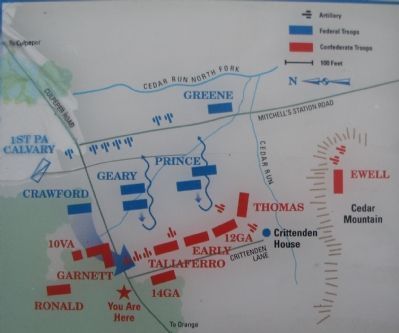
On 9 August 1862, the relative quiet of the American Civil War in Virginia was broken with the fight at Cedar Mountain, in Culpeper County, Virginia.


Confederate General Thomas "Stonewall" Jackson (Left) and Union General Nathaniel P. Banks (Right)
The Union had cobbled the remnants of the three Departments/Armies that suffered defeat at the hands of CS Gen. Thomas "Stonewall" Jackson during the Spring 1862 Shenandoah Valley campaign into a single force, the Union Army of Virginia, under the command of the pompous US Gen. John Pope. Pope had achieved a degree of success along the Mississippi earlier, and now came to Virginia with grand plans of crushing Robert E. Lee. He also came determined to treat Virginian civilians loyal to their state as traitors, and imposed draconian measures against them. Pope's Union Army of Virginia had in the vicinity of 50,000 men spread across Northern Virginia.
CS General Robert E. Lee, with his Confederate Army of Northern Virginia, had succeeded in knocking the fight out of US Gen. George McClellan and the Union Army of the Potomac a month before, and even now watched as McClellan's grand army slowly evacuated from Harrison's Landing on the James River back to Washington, DC. The remaining army was to big to defeat, and without an adequate Naval force, there was little that could be done to stop the evacuation. Pope's army, however, was of a size that Lee and his Army of Northern Virginia could perhaps contend with -- at least until the remainder of McClellan's army returned to that area. So Lee would shift his forces north to deal with Pope, counting on McClellan and the Army of the Potomac having permanently given up the initiative.
So it was that Stonewall Jackson, commanding 22,000 men -- half of Lee's army -- crossed the Rapidan River into Culpeper County, hoping to deal a blow to a portion of Pope's army, the II Corps, US Army of Virginia, under US General Nathaniel Banks (who had been beaten by Jackson at Winchester that Spring), with his 12,000 men.

A map of the action, entitled the Battle of Cedar Run, after an alternate name for the Battle of Cedar Mountain.
Despite some surprising temporary success for this outnumbered Union force, they mauled the division of CS Gen Charles Winder, mortally wounding him, in the end, the Confederates carried the day. Stonewall Jackson actually rallied his men by waving his still-sheathed sword over his head as he also clutched a flag in his other hand.

Jackson at Cedar Mountain rallying his men!
The NPS account of the Battle can be found here: http://www.cr.nps.gov/hps/abpp/battles/va022.htm
If you wish to visit the ground of the battle, the sign at this link marks the center of action. There is actually a short hiking trail and a few other orientation signs offered to the public at the site by the Civil War Preservation Trust: http://www.hmdb.org/Marker.asp?Marker=41662

Detail from the battle map on the Civil War Trails sign at the battlesite.
After this battle in which Jackson suffered 1,400 casualties to Banks' 2,500, Jackson withdrew back across the Rapidan to wait for the rest of the Army of Northern Virginia. Soon a new offensive would begin that would take the army back into an old battleground. At the end of the month they would be back along the banks of the Bull Run in Manassas...
Live well!
No comments:
Post a Comment